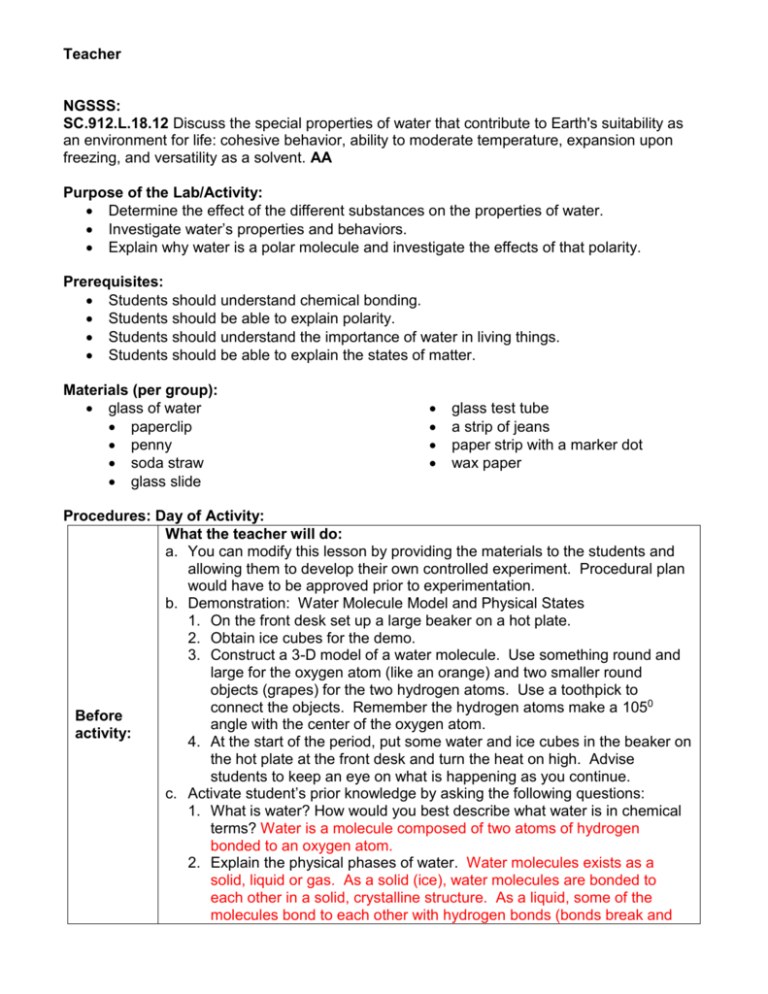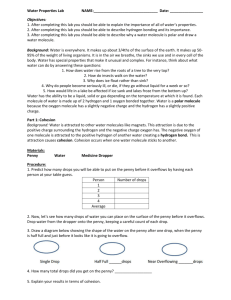NGSSS: - Gulf Coast State College
advertisement

Teacher NGSSS: SC.912.L.18.12 Discuss the special properties of water that contribute to Earth's suitability as an environment for life: cohesive behavior, ability to moderate temperature, expansion upon freezing, and versatility as a solvent. AA Purpose of the Lab/Activity: Determine the effect of the different substances on the properties of water. Investigate water’s properties and behaviors. Explain why water is a polar molecule and investigate the effects of that polarity. Prerequisites: Students should understand chemical bonding. Students should be able to explain polarity. Students should understand the importance of water in living things. Students should be able to explain the states of matter. Materials (per group): glass of water paperclip penny soda straw glass slide glass test tube a strip of jeans paper strip with a marker dot wax paper Procedures: Day of Activity: What the teacher will do: a. You can modify this lesson by providing the materials to the students and allowing them to develop their own controlled experiment. Procedural plan would have to be approved prior to experimentation. b. Demonstration: Water Molecule Model and Physical States 1. On the front desk set up a large beaker on a hot plate. 2. Obtain ice cubes for the demo. 3. Construct a 3-D model of a water molecule. Use something round and large for the oxygen atom (like an orange) and two smaller round objects (grapes) for the two hydrogen atoms. Use a toothpick to connect the objects. Remember the hydrogen atoms make a 1050 Before angle with the center of the oxygen atom. activity: 4. At the start of the period, put some water and ice cubes in the beaker on the hot plate at the front desk and turn the heat on high. Advise students to keep an eye on what is happening as you continue. c. Activate student’s prior knowledge by asking the following questions: 1. What is water? How would you best describe what water is in chemical terms? Water is a molecule composed of two atoms of hydrogen bonded to an oxygen atom. 2. Explain the physical phases of water. Water molecules exists as a solid, liquid or gas. As a solid (ice), water molecules are bonded to each other in a solid, crystalline structure. As a liquid, some of the molecules bond to each other with hydrogen bonds (bonds break and Teacher During activity: After activity: reform continuously). As a gas, water vapor, the water molecules are not bonded to each other (they float as single molecules). 3. Water is a polar molecule. What does that mean? It means that there is an uneven distribution of electron density. Water has a partial negative charge near the oxygen atom due to the unshared electrons, and partial positive charges near the hydrogen atoms. d. Have students write a hypothesis for each of the following water concepts: To do this you need to pick a specific substance from the materials list to test for each hypothesis. e. Students should have eight hypotheses. For example, one hypothesis might be: If the substance used is the penny then the water will group together and show surface tension. f. The group’s hypotheses must be approved prior to experimentation. What the teacher will do: a. Monitor students to make sure they are remaining on task and are following their procedural plan. b. Review the experimental design diagram by asking individual students in groups to explain the different parts of the experiment. c. Follow laboratory procedural plan; making sure to model proper laboratory safety and use of equipment. d. Emphasize importance of data collection by groups. e. Ask the following questions: 1. How many drops of water can you place on a penny? Why do you think this? 2. Predict what would happen if you added soap to the water, would the penny be able to hold more water. Explain why. 3. What will the drop of water look like on the wax paper? Why do you think this? 4. Predict what will happen to the drop on the paper when it is placed in the beaker? Why do you think this? 5. What will happen when the straw is placed in a beaker of water? 6. Describe the properties of water do you think are responsible for water’s unique behaviors? What the teacher will do: a. Analyze class data; making sure to note the importance of multiple trials, and repeatability in scientific investigations. b. Answer Key for Results: 1. How did this investigation demonstrate cohesion, adhesion surface tension and capillary action? 2. What implications do these concepts have for living things? Answers will vary. 3. Have you ever done a belly flop? If so explain how it felt and what property of water caused you to feel pain. If not, guess what property of water causes the pain felt from doing a belly flop. Answers will vary. Doing a belly flop stings because of water’s surface tension. 4. Why is water important for keeping animals cool? How does sweating cool us down? Water is the medium in which all chemical reactions in the body take place. Water regulates animal’s body temperature. By Teacher sweating, animals attempt to lose extra body heat via evaporative cooling. 5. Why does ice float? Why is this important to the fish in a lake? Ice floats because it is less dense than liquid water. If water did not act like this any fish or other organisms that live in the lake would not be able to survive during the winter. 6. What are the terms used to describe waters attraction to itself and other things? What bonding allow for this? What does the charge of the molecule have to do with its properties? Water is attracted to other water. This is called cohesion. This is due to the polarity of the water molecule and the hydrogen bonding involved. The hydrogen of one molecule (positive charge) are attracted to the oxygen (negative charge) of another molecule. Water can also be attracted to other molecules. This is called adhesion. 7. What attraction is important to water striders? Surface tension Extension: Web Tutorial: Properties of Water Gizmo: Element Builder Student Properties of Water NGSSS: SC.912.L.18.12 Discuss the special properties of water that contribute to Earth's suitability as an environment for life: cohesive behavior, ability to moderate temperature, expansion upon freezing, and versatility as a solvent. AA Background: Water is the most common substance on Earth. Nearly three-quarters (about 70 percent) of the Earth’s surface is covered with water. Water is unique because it is the only substance that occurs naturally on Earth in all three states—solid, liquid, and gas. About 2 percent of the world’s water is solid, including snow, frost, glaciers, and the polar ice sheet. Less than onethousandth of a percent of the world’s water is gaseous, as water vapor. The rest of the world’s water is liquid, and can be found in oceans, seas, lakes, rivers, streams, and groundwater. Sometimes we call water H2O. That’s because water molecules have two hydrogen atoms and one oxygen atom. While water molecules are neutral as a whole, one end of the water molecule tends to have a positive charge while the other has a negative charge (polarity). Each end of a water molecule is attracted to the opposite charged end of another water molecule. This is called “hydrogen bonding.” Cohesion is the attraction of water molecules to other molecules. It is the result of hydrogen bonding – the attraction of the hydrogen atoms in water to the oxygen atoms in water. It is the property that allows water droplets to form. Cohesion is responsible for surface tension. This property allows some insects to walk across water. Adhesion is the ability of water to stick to other surfaces. For example, water forms on mirrors in a steamy bathroom. Adhesion is a property that causes water to be drawn up through soil and into paper towel. When water is drawn up through small spaces, it is called capillary action. Water is an amazing substance that is critical to life. It serves a purpose in various processes such as cellular metabolism, heat transfer, and structural support. For these reasons and more, the presence of water is a good indicator that life may be sustainable in certain environments, such as the Jovian moon of Europa. Problem Statement: What are the properties of water that contribute to living things? Safety: Report any spills immediately to the teacher. Use napkins routinely to clean up your lab area. Vocabulary: polar, nonpolar, adhesion, cohesion, surface tension, capillary action, solvent Materials (per group): glass of water paperclip penny soda straw glass slide glass test tube a strip of jeans paper strip with a marker dot wax paper Student Procedures: Write a hypothesis for each of the following water concepts: adhesion, cohesion, surface tension, capillary action To do this you need to pick a specific substance from the materials list to test for each hypothesis. You should have eight hypotheses. For example, one hypothesis might be: If the substance used is the penny then the water will group together and show surface tension. After getting approval for all of your hypotheses you will need to write your procedures. It may help you to look at the data table. Observations/Data: Check the appropriate box if the listed property occurred in your experiment. Polar or Non-Polar must be selected for each investigation. Properties of Water Substance Polar Non-Polar Adhesion Cohesion Surface Tension Putting paper clip in water Pouring water on penny Putting regular straw in water Putting jean strip in water Putting paper strip with dot in water Pouring water on glass slide Pouring water on wax paper Putting water in test tube You should also collect qualitative data such as observations about each substance. Results: 1. From the data collected, what happened in each of the 8 procedural plans? Capillary Action Student 2. How do you know those substances possess the qualities of the ones you checked? Conclusion: 1. How did this investigation demonstrate cohesion, adhesion surface tension and capillary action? 2. What implications do these concepts have for living things? 3. Have you ever done a belly flop? If so explain how it felt and what property of water caused you to feel pain. If not, guess what property of water causes the pain felt from doing a belly flop. 4. Why is water important for keeping animals cool? How does sweating cool us down? 5. Why does ice float? Why is this important to the fish in a lake? 6. What are the terms used to describe waters attraction to itself and other things? What bonding allow for this? What does the charge of the molecule have to do with its properties? 7. What attraction is important to water striders?








